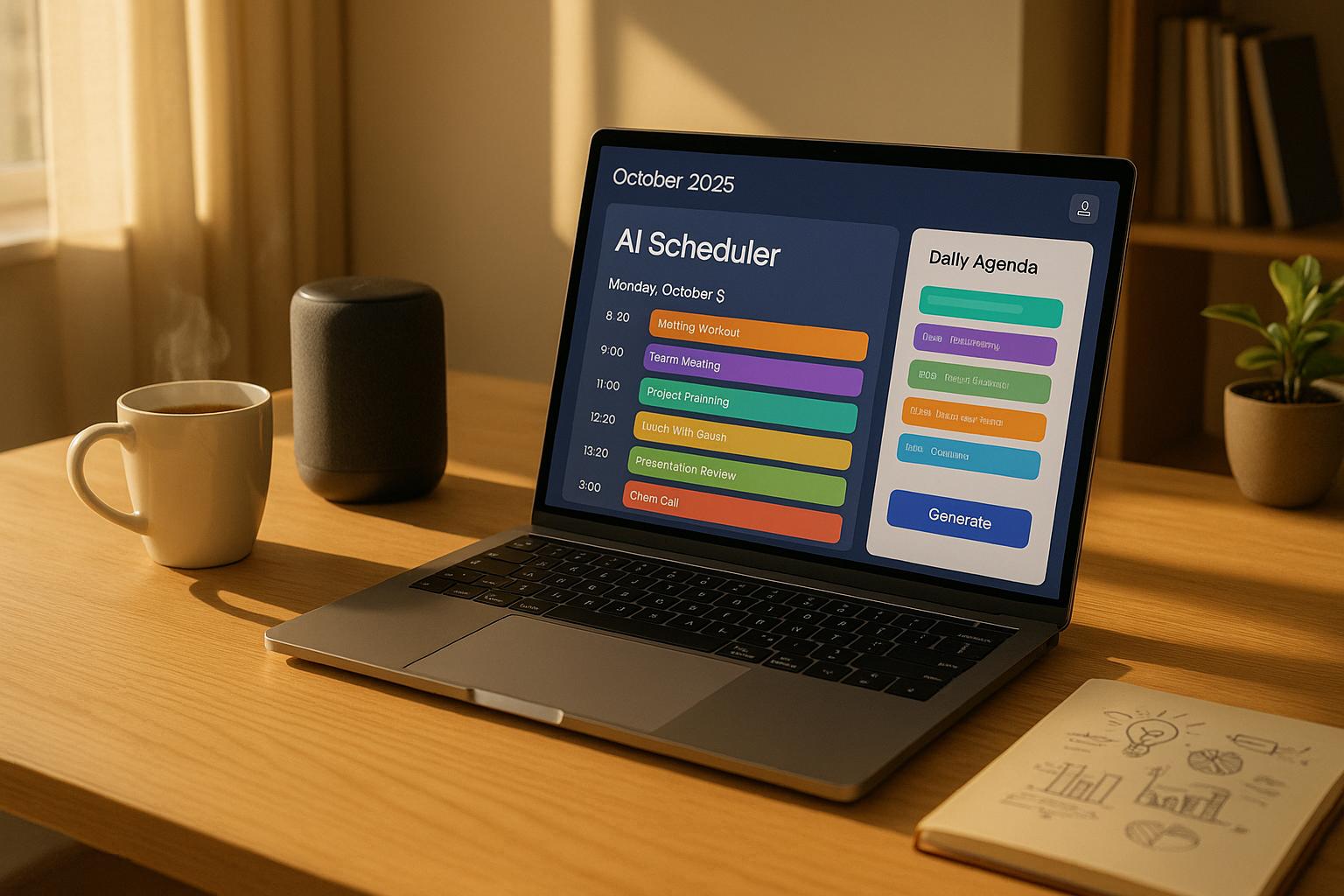AI tools are changing how businesses work by saving time, improving decisions, and solving problems. Here's why they matter:
- Boost Productivity: Automate repetitive tasks like reports, emails, and workflows.
- Better Decisions: Analyze large data sets for insights, trends, and forecasts.
- Save Costs: Reduce expenses in customer service, hiring, and supply chains.
- Creative Solutions: Help generate fresh ideas and speed up research.
- Risk Management: Identify and prevent issues like fraud or supply chain disruptions.
- Future Growth: Industries like banking, healthcare, and logistics are already seeing billions in value from AI.
Quick Comparison: AI Tools vs. Traditional Software
| Aspect | Traditional Software | AI Tools |
|---|---|---|
| Operation | Fixed instructions | Learns from data |
| Adaptability | Manual updates | Self-improving |
| Data Handling | Static tasks | Complex data processing |
| Scalability | Manual scaling | Self-optimizing |
| Output | Deterministic results | Probabilistic estimates |
AI tools are reshaping industries by automating tasks, cutting costs, and unlocking smarter ways to work. From better customer service to faster research, they are becoming essential for businesses to stay competitive.
How AI Could Empower Any Business
How AI Tools Boost Work Output
AI tools are changing the way organizations handle daily tasks, helping teams work more efficiently. By automating repetitive tasks and analyzing complex data, these tools free up time for teams to focus on strategic priorities. This shift starts with streamlining routine operations, enabling employees to tackle more complex challenges.
Handling Routine Tasks
AI-powered tools are great at taking over repetitive tasks that often consume valuable time. According to McKinsey, AI technologies have the potential to automate up to 70% of these tasks.
Here are some examples of how AI is being used to simplify work processes:
| Task Type | AI Solution | Key Benefits |
|---|---|---|
| Project Management | Trello AI Report Generator | Quickly creates reports from board data |
| Workflow Automation | Asana AI Studio | Enables no-code workflow design and deployment |
| Customer Communication | HubSpot Breeze | Automates email drafts and chatbot responses |
| Marketing Operations | Intuit Assist (Mailchimp) | Handles email design and list management |
| Content Creation | Adobe Sensei | Generates content and plans campaigns |
"I think you all should jump on the wave that's coming, but it's the individual productivity that I think is already here today. And this is where you hear all these fun anecdotes like you can go and do someone's job 20 percent faster if you have AI with you as a co-pilot."
– Jen Stave, launch director of Harvard's Digital Data Design (D³) Institute
Making Better Choices with AI Data
AI tools also improve decision-making by processing large datasets and providing actionable insights. Companies using AI for decision-making report better accuracy and efficiency. Research shows:
- Decision leaders achieve five times higher shareholder returns.
- Teams make decisions 2–4 times faster while cutting analytics costs by 30%.
- Inclusive decision-making leads to 87% better outcomes.
Google Cloud's AI Hub is a prime example, allowing teams to create custom AI models using their own data. These models can quickly analyze lengthy documents and perform detailed data evaluations.
"Analytics and insights should not just explain the past but tell you what the business needs to do tomorrow, creating consumer foresight that leads to decision-driven action."
– Kalindi Mehta, VP of Consumer Foresight & Predictive Analytics, Estee Lauder
AI tools contribute to smarter decision-making in several ways:
- Predictive Analytics: Helps forecast trends and spot risks.
- Automated Reporting: Transforms complex data into clear insights.
- Performance Monitoring: Tracks metrics and suggests improvements.
- Resource Allocation: Helps optimize workloads and timelines.
These capabilities are especially important in today's fast-paced business environment. In fact, 79% of corporate strategists believe AI and analytics will play a critical role in their success over the next two years.
AI Tools for New Ideas and Solutions
AI tools are not just about boosting productivity - they also play a big role in solving problems creatively and advancing research. With the help of advanced algorithms, these tools offer new perspectives and make research faster and more effective.
AI-Powered Idea Generation
Jasper's Marketing AI Toolkit is a great example of how AI can help generate content ideas while staying true to a brand's identity. Nick Kakanis, SVP of Operations at Pilot Company, highlights its impact:
"Jasper's brand and voice tools help our teams align and collaborate effectively"
Here are some AI tools designed to spark creativity:
| Tool Name | Key Features | Starting Price |
|---|---|---|
| Design Sparks | Problem-solving, Free-form brainstorming | Free |
| Seenapse | Lateral thinking, Unique concept creation | $4.99/month |
| Stormz | Team collaboration, Idea organization | $10/month |
| Ideator | UX-focused ideation, Scenario planning | Free |
These tools help teams tackle creative blocks and think outside the box. Dara Cohen, Sr. Manager of Campaign Strategy at CloudBees, shares her experience:
"We can be way more creative in what we're putting out into the world"
Beyond creativity, AI tools also speed up research, helping teams move from ideas to execution more efficiently.
Faster Research Results
AI tools are transforming research by processing large datasets quickly to uncover valuable insights. Inbal Shani, Chief Product Officer at Twilio, explains how this changes the game:
"Having more data points can change business leaders' strategy and prioritization decisions. AI can help analyze data sets and be an unbiased element in the conversation. After strategic decisions are made, AI can then help continuously monitor metrics and evaluate the progress."
Here are some notable examples of companies using AI to advance research and development:
1. Rolls-Royce Aerospace
Their AI system analyzes sensor data from aircraft engines to predict maintenance needs, cutting costs and improving safety.
2. Pfizer's Drug Discovery
Partnering with IBM Watson, Pfizer uses AI to streamline drug discovery, significantly reducing development timelines.
3. L'Oréal's Market Research
By analyzing social media trends and customer reviews, L'Oréal uses AI to create products that match current beauty trends.
AI's role in speeding up research is undeniable. In fact, nearly 23% of manufacturers have already integrated AI into their production processes. Mark Wollney, SVP of Operations at MERGE, highlights this shift:
"This isn't just about staying relevant in a rapidly evolving industry; it's about leading the way"
Here are some ways AI enhances research:
- Pattern Recognition: Detects trends and relationships in data
- Real-time Analysis: Delivers instant feedback on tests and market data
- Predictive Insights: Anticipates market needs and opportunities
- Collaboration Across Teams: Makes research findings accessible to all departments
These features help teams move quickly from brainstorming to execution without compromising on quality.
sbb-itb-212c9ea
How AI Tools Fix Business Problems
AI tools are transforming how businesses tackle challenges, from cutting expenses to managing risks and streamlining supply chains. Here’s a closer look at how AI is driving these changes.
Cutting Costs Through AI
AI isn't just about innovation - it’s saving companies money. McKinsey's latest report shows that 33% of businesses now use generative AI tools to reduce costs, with 28% reporting savings of up to 10%.
"The savings can be 10 or 20 times" – Mark Read, CEO of WPP
Here’s how AI is helping across different areas:
| Business Area | AI Impact | Cost Reduction |
|---|---|---|
| Customer Service | 9% reduction in handling time | 14% more resolutions per hour |
| Recruitment | Lower cost-per-hire | 71% reduction |
| Maintenance | Boosted productivity | 25% improvement, 70% fewer breakdowns |
| Supply Chain | Improved forecasting | Up to 30% lower transportation costs |
Take Walmart's Sam's Club warehouses, for instance. They use AI-powered floor scrubbers equipped with inventory intelligence towers, capturing over 20 million shelf photos daily to manage 6,000 items. Beyond saving money, AI also helps businesses stay ahead of potential risks.
Risk Prevention with AI
AI tools are redefining risk management by identifying problems before they escalate. For example, a small financial institution using Previse's predictive analytics cut fraud-related losses by 30%.
Here are some standout AI tools for risk management:
| Tool Name | Specialization | Best For |
|---|---|---|
| RiskWatch | Risk management | Large enterprises |
| LogicGate | Compliance and workflow automation | Mid-sized companies |
| CyberGRX | Third-party risk monitoring | Tech companies |
| Quantifind | Financial crime detection | Banking sector |
| Riskified | Fraud prevention | Online retailers |
By using these tools, companies can safeguard their operations while staying compliant and secure.
Better Supply Chain Management
AI is reshaping supply chains, making them more efficient and resilient. Companies using AI report a 15% drop in logistics costs, 35% lower inventory levels, and a 65% improvement in service levels. For example:
- DHL's Resilience360 platform predicts disruptions from cyberattacks to natural disasters.
- Mazda Motor Logistics uses Oracle Transportation Management to optimize its European distribution.
"[It's] almost like you have a human assistant sitting next to you who could alert you to things you otherwise wouldn't have known about" – Walter Sun, SVP and global head of AI at SAP
Looking ahead, AI's role in supply chains will only grow. By 2028, smart robots are expected to outnumber frontline workers in industries like manufacturing and retail, with 95% of data-driven decisions becoming at least partially automated.
What's Next for AI Tools
AI has already made a strong impact on productivity and decision-making. The next big steps focus on advancing technology and ensuring responsible use. AI continues to reshape how businesses operate, with 49% of technology leaders reporting full integration of AI into their core business strategies.
New AI Developments
One area gaining attention is autonomous AI agents - intelligent assistants capable of handling complex tasks independently. By 2025, 25% of enterprises using generative AI are expected to adopt these assistants.
Here's how AI is set to influence various industries:
| Industry | Expected Impact | Impact Value |
|---|---|---|
| Banking | Boosted productivity through AI | $340 billion annually |
| Healthcare | Automation of tasks | 25% of current work |
| Product Development | Faster design cycles | 50% reduction in cycle time |
| Enterprise Ops | Increased cloud investments | 63% of leading companies |
"By this time next year, you'll have a team of agents working for you. This could look like anything from an IT agent fixing tech glitches before you even notice them, a supply chain agent preventing disruptions while you sleep, sales agents breaking down silos between business systems to chase leads, and finance agents closing the books faster."
This quote highlights the growing role of AI agents in streamlining business functions.
Some key advancements expected by 2025 include:
1. Voice AI Evolution
Voice AI is anticipated to pass the speech Turing test, paving the way for broader personal use and new forms of human-AI communication.
2. Dark Data Utilization
A large portion of data today is unstructured - such as documents, videos, and audio. Andi Gutmans, VP/GM of Databases at Google Cloud, predicts:
"2025 is the year where dark data lights up. The majority of today's data sits in unstructured formats such as documents, images, videos, audio, and more. AI and improved data systems will enable businesses to easily process and analyze all of this unstructured data in ways that will completely transform their ability to reason about and leverage their enterprise-wide data."
As these developments accelerate, ensuring secure and ethical implementation becomes more important than ever.
Using AI Responsibly
With AI becoming a deeper part of business operations, responsible practices are no longer optional. Currently, 73% of executives plan to use generative AI to reshape their business models.
Key areas of focus for responsible AI use include:
| Focus Area | Implementation Strategy | Expected Outcome |
|---|---|---|
| Data Privacy | Secure storage and controlled access | Strengthened trust and compliance |
| Risk Management | Standardized AI risk frameworks | Better oversight and control |
| Workforce Training | New HR strategies for AI integration | Higher adoption rates |
| Ethical Review | Regular audits and monitoring | Alignment with ethical standards |
"We need to be sure that in a world that's driven by algorithms, the algorithms are actually doing the right things. They're doing the legal things. And they're doing the ethical things."
- Harvard Business School Professor Marco Iansiti
Ethical deployment is crucial for sustaining AI-driven improvements. Transparent systems and addressing privacy concerns are key. For instance, 86% of organizations reduced phishing risks within a year of security awareness training, showing the value of human oversight in AI implementation.
The future of AI tools hinges on balancing cutting-edge advancements with responsible practices. Companies that align innovation with ethical considerations will be better equipped to thrive in this evolving landscape.
Conclusion: Making the Most of AI Tools
AI tools are reshaping how businesses operate by improving productivity, decision-making, and problem-solving. From streamlining tasks to creating new solutions, their influence touches nearly every part of an organization.
The key to success lies in thoughtful integration and setting clear objectives. Harvard Business School Professor Karim Lakhani highlights this shift:
"I have a strong belief that the future of business is going to be AI-powered. There's not one organization, one role that will not be touched by AI tools."
Take Amazon, for example. Their AI-powered recommendation system drives up to 35% of their revenue by improving cross-selling opportunities. This shows how aligning AI strategies with business goals can lead to real, measurable outcomes.
| Success Factor | Strategy | Outcome |
|---|---|---|
| Clear Goals | Define specific business objectives | Measurable ROI |
| Data Quality | Regular audits and updates | Improved accuracy |
| Team Training | Ongoing learning programs | Higher adoption rates |
| Integration | Incorporate into workflows | Better productivity |
The Forrester Wave™ report underscores the importance of combining human expertise with AI:
"The true standouts are those that have gone beyond the basics, crafting enterprise-ready workflows that intelligently incorporate generative AI and ML. As buyers consider their options, they should prioritize vendors that not only incorporate AI and ML but also prioritize their role in augmenting human workflows, empowering frontline agents and operations staff."
To succeed with AI, businesses need to balance innovation with responsibility. This means reviewing outputs, verifying data, and staying transparent. As AI continues to evolve, companies that adopt it thoughtfully - while keeping human oversight and ethics at the forefront - will remain ahead of the curve.



